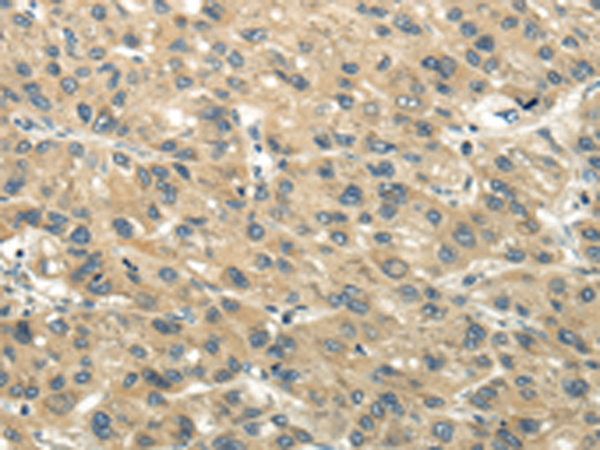
| WB | 咨询技术 | Human,Mouse,Rat |
| IF | 咨询技术 | Human,Mouse,Rat |
| IHC | 1/30-1/150 | Human,Mouse,Rat |
| ICC | 技术咨询 | Human,Mouse,Rat |
| FCM | 咨询技术 | Human,Mouse,Rat |
| Elisa | 1/2000-1/10000 | Human,Mouse,Rat |
| Aliases | SCG1 |
| Host/Isotype | Rabbit IgG |
| Antibody Type | Primary antibody |
| Storage | Store at 4°C short term. Aliquot and store at -20°C long term. Avoid freeze/thaw cycles. |
| Species Reactivity | Human, Mouse, Rat |
| Immunogen | Synthetic peptide of human CHGB |
| Formulation | Purified antibody in PBS with 0.05% sodium azide and 50% glycerol. |
+ +
以下是关于CHGB抗体的3篇代表性文献摘要及作者信息:
---
1. **文献名称**: **"Chromogranin A and B as markers of neuroendocrine tumors"**
**作者**: Lloyd RV, et al.
**摘要**: 该综述探讨了CHGA和CHGB作为神经内分泌肿瘤标志物的应用,指出CHGB抗体在免疫组化中特异性较高,尤其适用于鉴别低分化神经内分泌肿瘤,但其敏感性可能因组织类型而异。
---
2. **文献名称**: **"Comparative study of chromogranin A, chromogranin B and synaptophysin in gastrointestinal neuroendocrine tumors"**
**作者**: Portela-Gomes GM, et al.
**摘要**: 研究比较了CHGA、CHGB和Synaptophysin抗体在胃肠道神经内分泌肿瘤中的表达差异,发现CHGB抗体在检测胃和胰腺肿瘤时表现出更高的特异性,但灵敏度低于CHGA。
---
3. **文献名称**: **"Subcellular localization and functional characterization of chromogranin B in endocrine cells"**
**作者**: Hagn C, et al.
**摘要**: 通过免疫电镜和Western blot分析,验证了CHGB抗体在垂体、肾上腺等组织中的亚细胞定位,证明其可用于研究分泌颗粒的激素储存与释放机制。
---
如需更具体的研究方向或更新文献,建议补充关键词或限定研究领域。
Chromogranin B (CHGB), a member of the granin family of acidic secretory proteins, is primarily localized within secretory vesicles of neuroendocrine and neuronal cells. It is co-stored and released alongside neurotransmitters, hormones, and peptides, playing a critical role in granulogenesis, hormone packaging, and regulated secretion. CHGB shares structural and functional similarities with chromogranin A (CHGA), though it exhibits distinct tissue-specific expression patterns. It serves as a precursor for bioactive peptides like secretolytin, which may modulate innate immunity and microbial defense.
CHGB antibodies are widely used as immunohistochemical markers to identify neuroendocrine tumors (NETs), such as pheochromocytomas, paragangliomas, and neuroblastomas. Their diagnostic utility stems from CHGB's consistent presence in dense-core secretory granules, even in tumors with low CHGA expression. Beyond diagnostics, these antibodies facilitate research into neuroendocrine system dynamics, vesicular trafficking, and secretory pathway regulation. Recent studies also explore CHGB's potential role in neurodegenerative diseases and cardiovascular disorders, linked to its interaction with amyloidogenic proteins and vasoregulatory peptides. However, interpretation requires caution due to cross-reactivity risks and variable expression across neuroendocrine subtypes.
×